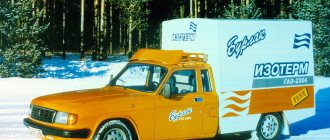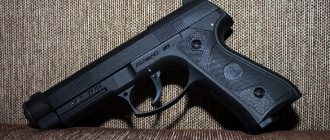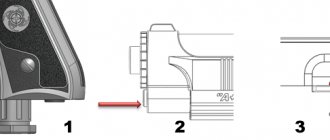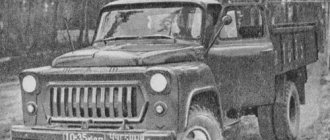Project development history
The family has a rich history. After the release of the next update, it was planned to launch mass production, but this never happened.
First generation (2000)
The GAZ-3106 Ataman 2 is based on a shortened chassis from the Ataman model of 1996. The axles, front suspension, steering, brake system and wheels are completely preserved. Some elements were taken from Sobol and unified. The design of the rigid rear axle with spring suspension allows the installation of a differential lock. This provides sufficient traction to all wheels. Intermediate shafts are eliminated from the design to ensure a quiet interior. To improve cross-country ability, the rear and front suspensions are made dependent.
GAZ-3106 is an SUV with all-wheel drive on a spar frame. Capacity - 7 people. For this purpose, three rows of seats are provided. It was planned to assemble technical components from parts from domestic and foreign companies (Iveco and Toyota). The prototype received a GAZ-561 power unit, which has 5 cylinders and develops 141 horsepower.
For passenger comfort, the seats are equipped with headrests. For safety, each seat has a retractable seat belt. The tank is installed inside the frame, this has a positive effect on passive safety. Also, thanks to this arrangement, it was possible to lower the floor in the cabin, but it did not turn out to be perfectly flat.
The rear suspension was deprived of the Watt mechanism, it was replaced by a Panhard mechanism. This is caused by the large number of hinges and the complexity of assembly. The simplified mechanism provides good stability on the road. The suspension is tuned for use on public roads, but this does not reduce the off-road ability.
Second generation (2004)
The development of the SUV was stopped in 2001 due to lack of funding. In 2004, looking at the successes of the Chevy Niva and Patriot, engineers proposed a new SUV with the old index. The retail price was planned to be set at around 10 thousand dollars. The project leaders abandoned the name “Ataman 2” so that consumers would not associate it with old developments.
The new car was built according to the classic SUV design. It had a spar frame, a five-door body, dependent suspension, all-wheel drive, a two-speed transfer case and a locking center differential. A ZMZ-405 power unit was placed under the hood, which develops 147 horsepower. The second generation GAZ-3106 met all modern requirements: the steering column was customizable in many ways, the design included power steering, and airbags and ABS were added for safety.
In 2005, at the international exhibition, the Gorky Automobile Plant presented two versions of 3106: basic and VIP. The second received leather interior trim and full power accessories. The back row has separate seats, each of which is electrically adjustable. The rear seats fold in a 1:2 ratio. The interior design is complemented by wooden elements on the dashboard.
In addition to external changes, technical characteristics have changed. The base engine was replaced with a 16-cylinder with a volume of 2.5 liters. It developed up to 204 horsepower. In the technical documentation, the mark of 170 km/h is indicated as the maximum speed. The standard engine developed up to 147 horsepower.
Third generation (2005)
The final development was an SUV, which received the index 31061. It was presented to the public in 2005. The wheelbase has become longer by 40 millimeters, the rear doors have been enlarged to increase comfort when boarding and disembarking passengers. Among the external differences, the chrome radiator grille, new design of headlights and bumper immediately catches the eye.
The salon is different from 3106 VIP. It became simpler, but retained the electric drive on the windows and mirrors. The back row folds in a 1:2 ratio. The trunk opens like a door and a spare tire is attached to it. The GAZ-5602 power unit has a volume of 2.13 liters and develops up to 120 horsepower.
The long-stroke dependent suspension is made of a spring type and is complemented by forged levers. It is based on the shortened Ataman base. The suspension is highly durable and allows you to overcome off-road conditions at high speed.
The planetary transfer case has two stages and operates via a Morse chain. The transfer case is supplemented with a lockable cylindrical center differential (made on the basis of the Volga gearbox; a limited slip differential can be installed on the rear axle).
Salon
Owner reviews note that, despite the high ground clearance, getting into the car is quite comfortable thanks to the step. As for the interior itself, for the most part it resembles a GAZ-3307.
There is still the same archaic instrument panel with round dials, steering column switches, a flat center console, on which there is only one radio and a small glove compartment that can be locked with a key. The dashboard trim is wooden. However, some versions used matte black plastic. The steering column is borrowed from the GAZelle and has the same range of adjustments. The pedals are also borrowed from this light-duty truck. The steering wheel is more “civilian”, taken from the Sobol. The car has two fabric seats without pronounced support.
A distinctive feature of the GAZ-2308 “Ataman” car is three levers between the driver and passenger seats. This scheme was previously used on Nivas. This means that in addition to the main gearshift lever, the car also has a transfer case (with reduction gear), as well as a differential lock.
Seat adjustment is only mechanical. Owner reviews note that the GAZ-2308 “Ataman” has a sufficient range of backrest adjustments. The seat itself rides on a “sleigh.” In a short period of time, you can select the appropriate position for the steering wheel and seat. The ceiling height allows you to accommodate even tall passengers. Another feature is the large glazing area. This has a positive effect on visibility. Also, the Ataman SUV (GAZ-2308) has comfortable cargo mirrors. They look harmonious against the general background and are quite informative for the driver.
What place does the GAZ-3106 take?
If the car is ever put into mass production, it will take a confident place between the Chevy Niva and the UAZ Patriot. The structure of the car is made according to the classic design of an SUV (frame and dependent suspension on springs). This has long been tested on the first generation Ataman. The shorter wheelbase that underpins the 3106 sits better on the road.
The latest generation received five seats (UAZ Patriot seats 7 people). As mentioned above, each seat is equipped with a headrest and an inertia-type seat belt. In the Patriot, the tank is located outside the frame, which reduces the level of passive safety. In the GAZ-3106 there are problems with folding the seats (the floor did not become level, this caused inconvenience when loading things into the luggage compartment).
Exterior
If you pay attention to the model’s appearance, it evokes quite mixed feelings. The car received 16-inch wheels, which had a positive effect on its exterior. The wheelbase reaches a length of 3,100 millimeters.
To understand this better, we can compare it with the famous Volga, which has this parameter 300 millimeters less. The ground clearance of the vehicle from the Gorky Automobile Plant is 215 millimeters, which indicates excellent cross-country ability.
The body frame is located quite high above the ground and with the help of the running boards, you can easily get into the pickup truck. For example, the GAZ-3106 model received an expressive appearance. The first models had a “brow-shaped” cabin, which could be a little embarrassing. Over time, later versions of the "jeep" were released.
The graceful and confident lines of the pickup truck’s exterior speak of the vehicle’s bold qualities, its dynamism, smooth ride and ability not to stop where there is simply no good road surface. This model already looked a little like a foreign car.
Chassis Features
Initially, the designers planned to introduce all-wheel drive with plug-in front-wheel drive into the car. But the engineers decided to take a difficult path, opting for permanent all-wheel drive. To do this, they had to develop a new transfer case from scratch, which operates using a multi-row leaf chain. It also features a lockable center differential. 2.68 - downshift number.
Interior
The three-seater cabin of both cars had plenty of spaciousness. Due to the fact that a huge glass area was installed, there was excellent visibility, which is very important. If we talk about the interior itself, then the pickup truck had a cargo-like and spartan look.
The only difference between the rear-wheel drive and all-wheel drive layouts was the number of transmission levers. The off-road version had a 5-speed manual gearbox lever along with a pair of auxiliary ones.
These included speed reduction and a locking center differential. The driver's seat was separated from the passenger seat.
The dashboard had many similarities with trucks from the Gorky Automobile Plant. On it, the largest sensor was assigned to the speedometer. The steering wheel has a two-spoke shape and a not very thin rim.
What can be concluded?
The GAZ-3106 SUV showed acceptable results during the first practical tests. In addition to being satisfied with the technical performance, testers liked the level of comfort inside the cabin. All controls are within easy reach, the windshield provides good visibility, and the soft seat allows you to travel many kilometers without discomfort.
After the international exhibition, the 3106 became interested not only in Russia, but also abroad. Despite great demand, it was not possible to bring the project to mass production. The official reason has not been announced; only guesses and information from unverified sources remain.
Volga GAZ-3106 is another promising project of a domestic manufacturer, which never reached the end consumer. If in the first years after the exhibition people believed that it would soon be possible to buy an SUV, now everyone has forgotten about it and is no longer waiting for serial production.
Prototypes
And even though GAZ froze it, it’s still worth looking at, albeit experimental, samples of the GAZ-3106. Serial production of an all-terrain vehicle, and this is how the development was presented, was supposed to start back in 2000. In the same year, GAZ was sold, a natural continuation of this purchase was a major reorganization. Many promising models were either frozen or cancelled, but prototypes of this car were developed until 2006.
So, what can we say about the GAZ-3106, which was never put into mass production? According to the plant's specifications, a 7-seater car was planned on a slightly shortened frame from the "Ataman" (more about it below) and with an original body, which was supposed to be installed on vibration-isolating cushions. According to the developers, such a solution should not only provide good vibration isolation, but also solve the noise problem.
The equipment of the car had to satisfy the tastes of the average consumer. Despite the positioning of the car in the off-road class, the specifications included airbags, electric drive for mirrors and windows, and ABS control. Of course, as for any SUV, a 5-speed manual was planned, but however, an automatic transmission was installed for additional money. Air conditioners could also be ordered as an additional option.
Inside, it was planned to repeat the interior of the tenth model, but for the convenience of the end user, the mechanics of adjusting the seats were redesigned. Just like many five-door versions, the rear seat could be folded in sections, which made it possible to carry a long load, and at the same time seat several passengers.
GAZ-67
This exceptional car has become on the same level as the lorry, because it played a big role during the Patriotic War.
Appearance of GAZ 67
The car was created at the factory according to the “all-terrain vehicle” principle. This car was supposed to drive under any conditions, on any road or off it. Therefore, they installed a 3.3 liter internal combustion engine on it. with a power of 54 l/s. despite this, the car gave all its best when it accelerated to 90 km/h. The car had a 4 manual transmission and a carburetor. We weren’t too worried about fuel consumption - the passport says 14 liters, in practice it’s 25 liters.
GAZ-64
This car was produced by the plant in 1941, when the war began. Therefore, the vehicle has more characteristics for the military than for the civilian population. The car was mainly intended for transporting commanders and senior officers. At that time, this was extremely necessary and cars were produced at the plant at a rapid pace. The vehicle could accommodate 8 officers, and a small caliber gun could also be transported in the back. This was very beneficial during the war.
This is what GAZ-64 looks like
GAZ-64 was created in the image of GAZ-61. Only in a shortened version. The car was shortened a little, it began to drive a little faster and perform maneuvers better.
The main disadvantage of a military SUV is the front suspension. It often broke due to the hard metal. When crossing terrain without a road, the car jumped a lot due to the speed of installation of shock absorbers and other parts. The gas SUV was popularly called “goat”. A little later, all the shortcomings of the chassis were corrected.
This is what the GAZ 61 suspension looks like
Advantages and disadvantages
Pros of the car
- Acceptable ride height;
- Excellent vehicle cross-country ability;
- There is an all-wheel drive system;
- There is hydraulic power steering;
- Powerful power units;
- Unpretentious model;
- Lots of free space inside;
- Male car silhouette;
- Can carry about 800 kilograms of luggage;
- ABS installed;
- Not afraid of bad roads;
- The front wheels have disc brakes;
- Good visibility.
Cons of the car
- The GAZ-2308 model has a rather sparse and ascetic interior, such as can be found on trucks;
- High fuel consumption;
- Large dimensions;
- Poor quality front panel made of plastic;
- The drag coefficient is high.











